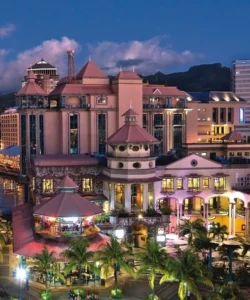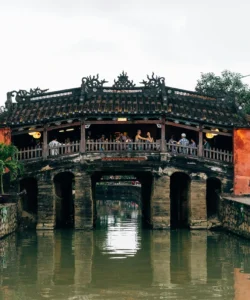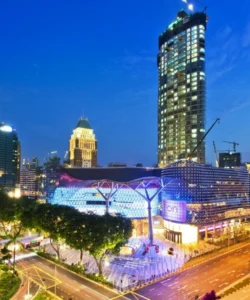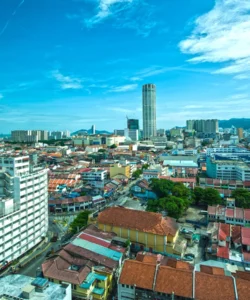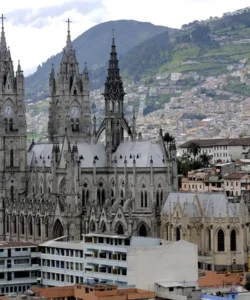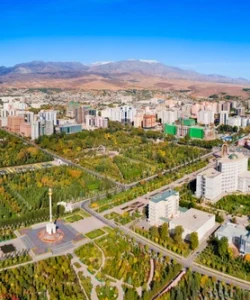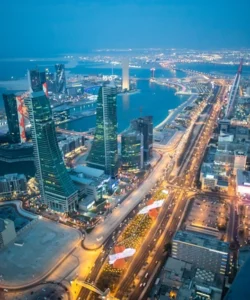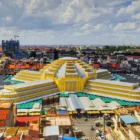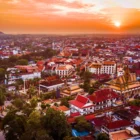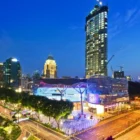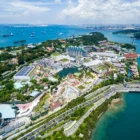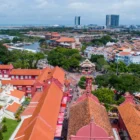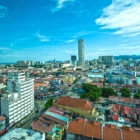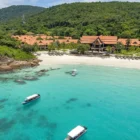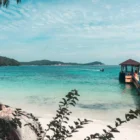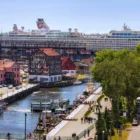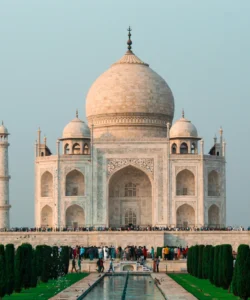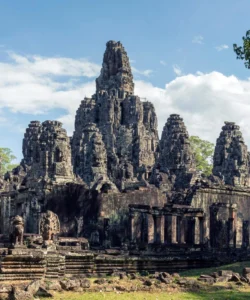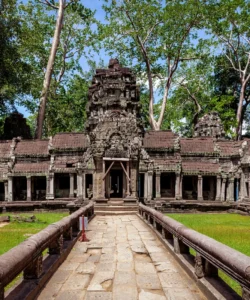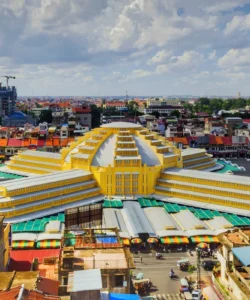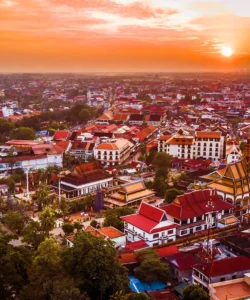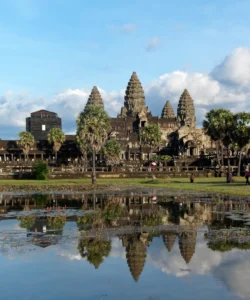Mongolia, a vast landlocked country in East Asia, is known for its expansive steppes, nomadic culture, and the legacy of its great historical figure, Genghis Khan.
Here’s a detailed overview:
Area: Approximately 1,564,116 square kilometers (603,909 sq miles), making it the 19th largest country in the world and the most sparsely populated.
Population: As of November 2022, the population was 3.4 million, with a very low population density of about 2 people per square kilometer.
Language: The official language is Mongolian (Khalkha Mongolian), spoken by 95% of the population. Other languages spoken include various dialects of Oirat and Buryat, as well as Turkic languages like Kazakh and Tuvan in the west.
Currency: The official currency is the Mongolian Tögrög (MNT), abbreviated as ₮. Denominations range from ₮1 to ₮20,000, though bills under ₮10 are no longer printed.
Religion: Buddhism (primarily Tibetan Buddhism, often called the “Yellow sect”) is the dominant religion, practiced by about 51.7% of the population. A significant portion (40.6%) are non-religious. Other religions include Islam (3.2%, predominantly among Kazakhs), Mongolian shamanism (2.5%), and Christianity (1.3%).
Capital: Ulaanbaatar. This vibrant city serves as the economic, cultural, and political center, blending modern urban life with traditional Mongolian lifestyles.
Cities: Besides Ulaanbaatar, other significant cities and towns often visited include Kharkhorin (the ancient Mongol capital), and regional centers near national parks.
Attractions: Mongolia offers a diverse range of attractions:
- Natural Wonders:
- Gobi Desert: A vast desert known for its towering sand dunes (Khongor Els), the Flaming Cliffs (Bayanzag) famous for dinosaur fossil discoveries, and diverse wildlife including the Bactrian camel.
- Terelj National Park: A popular and beautiful park near Ulaanbaatar, featuring forested alpine mountains, interesting rock formations like Turtle Rock, and opportunities to visit nomadic families.
- Lake Khövsgöl: Known as Mongolia’s “Blue Pearl” and the second clearest water lake in the world after Lake Baikal.
- Altai Mountains: Majestic peaks and glaciers in the far west, offering opportunities for hiking and cultural experiences with local Kazakh nomads and eagle hunters.
- Orkhon Valley Cultural Landscape: A UNESCO World Heritage Site with historical significance, featuring the ancient capital of Karakorum, Erdene Zuu Buddhist monastery, and Orkhon waterfall.
- Khorgo – Terkhiin Tsagaan Nuur National Park: Amazingly beautiful scenery with mountains, cliffs, rivers, lakes, extinct volcanoes, and forests.
- Historical and Cultural Sites:
- Chinggis Khan Statue Complex: A massive 40-meter tall equestrian statue of Genghis Khan, symbolizing proud Mongolian history.
- Erdene Zuu Monastery: The oldest surviving Buddhist monastery in Mongolia, located in Kharkhorin, showcasing traditional Mongolian architecture with Chinese and Tibetan influences.
- Gandantegchinlen Monastery: A major Buddhist monastery in Ulaanbaatar, home to an enormous 26.5-meter tall statue of Avalokitesvara.
- Winter Palace of the Bogd Khan: Once the residence of Mongolia’s last monarch, a blend of Mongolian, Russian, and Chinese architectural styles.
- Choijin Lama Temple Museum: An exquisite example of Buddhist architecture with intricate wood carvings and vibrant colors, now a museum.
- National Museum of Mongolia: Located in Ulaanbaatar, it houses a rich collection showcasing the country’s history and culture.
Architecture: Mongolian architecture is a unique blend of traditional nomadic designs with influences from Tibetan, Chinese, and Russian styles. Key examples include:
- Yurt-style architecture: Seen in some older monasteries like Dashchoilin Khiid.
- Buddhist monasteries: Erdene Zuu and Gandantegchinlen Monastery exemplify Buddhist architectural traditions with intricate details, bright colors, and elaborate layouts.
- Winter Palace of the Bogd Khan: A notable example of a palace incorporating Buddhist elements and foreign influences.
- Karakorum (ancient capital): While mostly in ruins, historical records describe grand structures like the Tumen Amugulang palace and a famous silver tree fountain.
Roads: Mongolia’s road network is not extensively developed, especially outside of Ulaanbaatar. As of 2010, only a small portion of the 6,738.8 km of engineered roads were paved (2,830.4 km), with a significant portion being gravel or earth roads. While the paved network reaches a good percentage of the population and GDP due to concentration in Ulaanbaatar, most international trade relies on railways. Maintenance of existing roads is also a challenge.
Hotels: Ulaanbaatar offers a wide range of accommodation options, from luxury international chains like Shangri-La, Kempinski, and Ramada to boutique hotels, capsule hotels, and guesthouses. Outside the capital, especially in more remote areas, “ger camps” (traditional nomadic yurts adapted for tourists) are a popular and authentic accommodation choice. Resorts and lodges are also available near popular natural attractions.
Restaurants: Ulaanbaatar has a diverse culinary scene, offering traditional Mongolian food alongside international cuisines like Chinese, Indian, Korean, Japanese, Italian, French, and Russian. Fast-food chains (KFC, Burger King, Pizza Hut) are also present. Traditional Mongolian barbecue is popular, especially in summer. Outside the capital, options are more limited and primarily focus on Mongolian cuisine.
Cuisine: Traditional Mongolian cuisine is hearty and meat-centric, reflecting the nomadic lifestyle. Staples include mutton, beef, camel, and horse meat. Key dishes to try:
- Buuz: Large steamed dumplings filled with meat (sheep or beef), onion, and garlic.
- Huushuur: Deep-fried meat pies.
- Tsuivan: Stir-fried noodles with meat and vegetables.
- Khorkhog: An authentic Mongolian barbecue, where meat (often goat or lamb) is cooked with hot stones inside a sealed container.
- Boodog: Meat (often goat or marmot) cooked inside its own skin with hot stones.
- Chanasan Makh: Boiled fatty meat with salt and sometimes vegetables.
- Borts: Dried meat, often consumed by nomads.
- Dairy products: A wide variety of dairy products are consumed, including aaruul (dried milk curds) and byaslag (Mongolian cottage cheese).
- Suutei Tsai: Salty milk tea, a staple beverage.
Annual Travel: Mongolia recorded 727,386 visitor arrivals in 2024, demonstrating a recovery in tourism. The country aims to further develop its tourism sector, attracting visitors drawn to its unique culture, vast landscapes, and adventurous experiences.
































